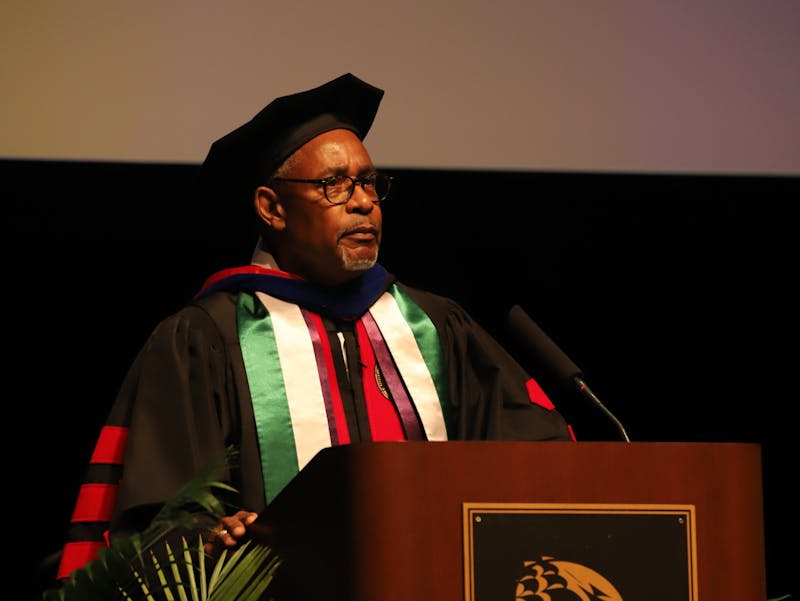As the sun was beaming through the stained glass windows of Old Main Chapel at Shippensburg University, a group of passionate professors gathered to discuss their new book, which is about imprisonment and disabilities in the U.S. and Canada.
The event, which took place on April 13, featured the work of three professors; Allison Carey, Chris Chapman and Liat Ben-Moshe, who collectively wrote “Disability Incarcerated.” They also gave a lecture that investigated specific issues of imprisoning people with disabilities.
Ben-Moshe, assistant professor of disability studies at the University of Toledo, began the event with a simple question to the audience, “How many of you are fans of ‘Orange is the New Black’?”
“We have learned a lesson about mental health from that series, but the topic is much more serious than that,” Ben-Moshe said as students began raising their hands one by one. “Tonight, we will have the chance to learn not only about people who are in prison and have a disability, but also about the institutions.”
Previous to the 19th century, imprisonment was used as a temporary punishment for very specific conditions or small crimes. Hospitals and prisons were very similar during the time but also vastly different.
“During the early 1800s there was not one place in the world that used imprisonment as the response to almost every crime that we tend to take for granted today,” said Chapman, an assistant professor at the School of Social Work at York University in Toronto.
Chapman said many poor people were placed into these institutions because they did not have a choice. People who had wealth or status were not put into these institutions, because they believed they did not belong there and had the ability to make that decision.
Over time, many people who were poor or lived with a disability often suffered severe abuse after being placed in the institutions. The custodial staff of these hospitals and prisons found it easy to manipulate and take advantage of the patients.
The institutional staff were always under constant scrutiny if something was not going as planned. It was their job to make sure people were being obedient and following the rules that were put in place.
It was not until the mid to late 1800s when prisoners were given daily tasks and strict rules to follow on a day-to-day basis.
“Prisoners were living by a clock. People thought this might help them become better people or maybe help them commit less crimes,” Chapman said.
Chapman ended his speech with a compelling question to the audience, regarding prisons and the patients who suffered within these institutions, “How can we be accountable for people who are born to live in these terrible places?”
Carey, who is an assistant professor of sociology and director of the disabilities studies interdisciplinary minor at SU, continued the talk with more information regarding these institutions and how all the situations intertwine over time.
“In the early 20th century we see a rise in these medical institutions for people with disabilities,” Carey said. “These were vast, expensive and largely ineffective systems. These systems focused not on treatment but on control, and served as a parallel system to the prison system itself.”
The success of deinstitutionalization has been limited over time. Society now relies heavily on the prison system for incarcerating people with disabilities.
Many psychiatric institutions are becoming more and more like prisons. They are not getting better — they are only getting worse as time goes on, according to Carey.
“What people with intellectual disabilities need today are more educational opportunities, they need to be in the community, they need access to their families and they need life experiences,” Carey said, before Ben-Moshe followed on the topic.
“The U.S. is only 5 percent of the world’s population, but it houses 25 percent of the world’s prison population,” Ben-Moshe said, “Prisoners are not randomly selected — they do not represent all statuses of society.”
“The majority of prisoners are poor and people of color. Poverty is known to cause a variety of impairments and disabling conditions."
Ben-Moshe said prison is very disabling to all people who enter, whether they have a disability or not. Many people who go into prisons without any type of a disability often leave with some sort of impairment, since many prisons and institutions house people in very poor conditions.
In regard to the mental health within these institutions, the American Psychiatric Association reports in 2000 that up to 5 percent of prisoners are actively psychotic, and as many as one in five prisoners are seriously mentally ill. When people are placed within these prisons, many of them get worse before they can get better.
Ben-Moshe ended the talk with another question for the audience, "What do you all think about this? What do you believe is the problem that you see here?"
With this question at the forefront of everyone's minds, she concluded that society has a long way to go regarding the way our psychiatric institutions and prisons are run.
4/21/2015, 12:11am



The Slate welcomes thoughtful discussion on all of our stories, but please keep comments civil and on-topic. Read our full guidelines here.